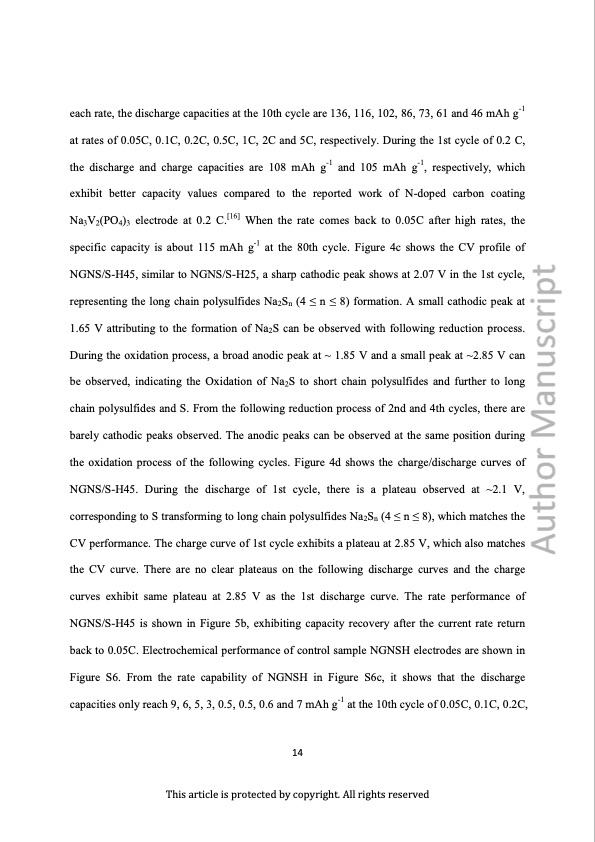
PDF Publication Title:
Text from PDF Page: 015
each rate, the discharge capacities at the 10th cycle are 136, 116, 102, 86, 73, 61 and 46 mAh g-1 at rates of 0.05C, 0.1C, 0.2C, 0.5C, 1C, 2C and 5C, respectively. During the 1st cycle of 0.2 C, the discharge and charge capacities are 108 mAh g-1 and 105 mAh g-1, respectively, which exhibit better capacity values compared to the reported work of N-doped carbon coating Na3V2(PO4)3 electrode at 0.2 C.[16] When the rate comes back to 0.05C after high rates, the specific capacity is about 115 mAh g-1 at the 80th cycle. Figure 4c shows the CV profile of NGNS/S-H45, similar to NGNS/S-H25, a sharp cathodic peak shows at 2.07 V in the 1st cycle, representing the long chain polysulfides Na2Sn (4 ≤ n ≤ 8) formation. A small cathodic peak at 1.65 V attributing to the formation of Na2S can be observed with following reduction process. During the oxidation process, a broad anodic peak at ~ 1.85 V and a small peak at ~2.85 V can be observed, indicating the Oxidation of Na2S to short chain polysulfides and further to long chain polysulfides and S. From the following reduction process of 2nd and 4th cycles, there are barely cathodic peaks observed. The anodic peaks can be observed at the same position during the oxidation process of the following cycles. Figure 4d shows the charge/discharge curves of NGNS/S-H45. During the discharge of 1st cycle, there is a plateau observed at ~2.1 V, corresponding to S transforming to long chain polysulfides Na2Sn (4 ≤ n ≤ 8), which matches the CV performance. The charge curve of 1st cycle exhibits a plateau at 2.85 V, which also matches the CV curve. There are no clear plateaus on the following discharge curves and the charge curves exhibit same plateau at 2.85 V as the 1st discharge curve. The rate performance of NGNS/S-H45 is shown in Figure 5b, exhibiting capacity recovery after the current rate return back to 0.05C. Electrochemical performance of control sample NGNSH electrodes are shown in Figure S6. From the rate capability of NGNSH in Figure S6c, it shows that the discharge capacities only reach 9, 6, 5, 3, 0.5, 0.5, 0.6 and 7 mAh g-1 at the 10th cycle of 0.05C, 0.1C, 0.2C, 14 This article is protected by copyright. All rights reservedPDF Image | Nitrogen-Doped Graphene Nanosheets Composites as Cathode in Sodium-Sulfur Batteries

PDF Search Title:
Nitrogen-Doped Graphene Nanosheets Composites as Cathode in Sodium-Sulfur BatteriesOriginal File Name Searched:
slct-201701951.pdfDIY PDF Search: Google It | Yahoo | Bing
Sulfur Deposition on Carbon Nanofibers using Supercritical CO2 Sulfur Deposition on Carbon Nanofibers using Supercritical CO2. Gamma sulfur also known as mother of pearl sulfur and nacreous sulfur... More Info
CO2 Organic Rankine Cycle Experimenter Platform The supercritical CO2 phase change system is both a heat pump and organic rankine cycle which can be used for those purposes and as a supercritical extractor for advanced subcritical and supercritical extraction technology. Uses include producing nanoparticles, precious metal CO2 extraction, lithium battery recycling, and other applications... More Info
| CONTACT TEL: 608-238-6001 Email: greg@infinityturbine.com | RSS | AMP |